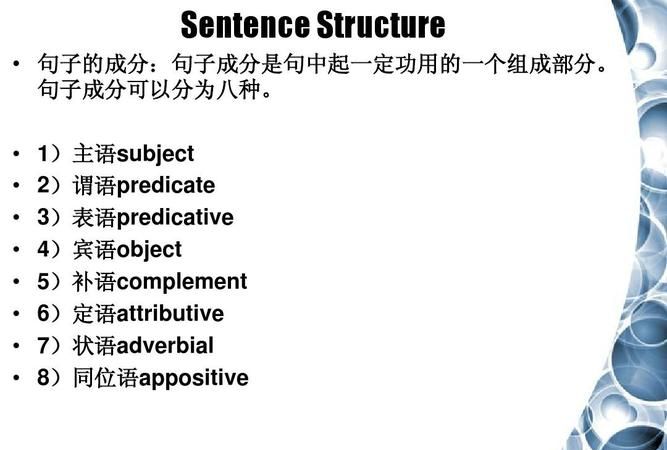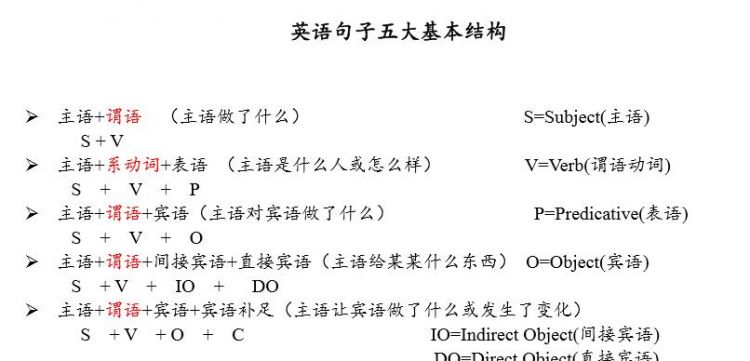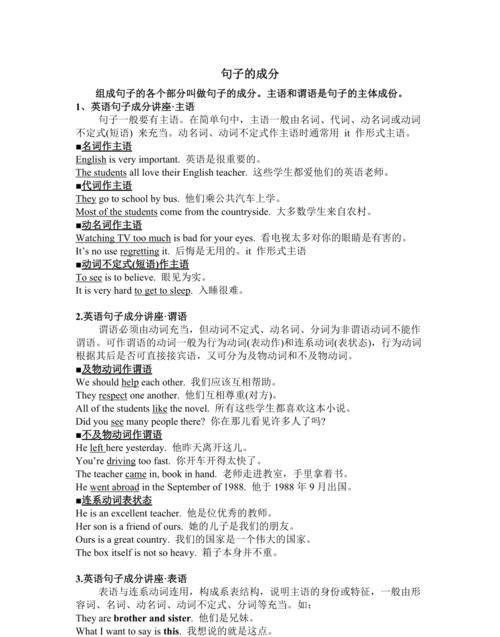本文目录
初中英文句子成分划分
英语 句子 是 英语学习 的基础,通过句子,强化语音语调,通过句子,巩固词汇的运用,通过句子,巩固语法知识,通过句子,达到交际和运用的目的。下面是我带来的初中英文句子成分划分,欢迎阅读!
初中英文句子成分划分精选
一、句子成分精讲
句子成分:主语、谓语、宾语、表语、定语、状语、补语等。
主要成分:主语和谓语
1、主语
一个句子中需要加以说明或描述的对象。主语的位置:
The school is far from here. 名词做主语
She goes to school by bike.
Eight is a lucky number.
The blind need more help. 代词做主语 数词做主语 名词化的形容词做主语
There is a pen on the desk. 名词做主语
Predicting the future is interesting.
To be a doctor is my dream.
2、谓语
表示人或事物(主语)的动作和存在的状态.
英语中由动词be、动词have和行为动词来充当谓语动词 句子的时态和语态是通过谓语表现出来。
谓语动词往往由一个或一个以上的构成。 分析句子的主语和谓语
Mr. Li teaches English.
He can play the piano.
My parents and I are having dinner.
3、表语
用来说明主语的身份、特征、性质、状态。
表语的位置
用在动词be和系动词的后面。
名词、代词、数词、介词 短语 、副词等都可以和连系动词一起构成复合谓语。 Your pen is on the desk.
He got very angry.
My dream is to have a robot.
常见的系动词 动名词做主语 不定式短语做主语
1. be动词
2. 与感觉有关的动词 look, sound, smell, taste, feel 等
3. 表示状态变化的动词,意为“变得” “变成” 如 get, grow, turn等
上述两类词作连系动词时要用形容词作表语,千万不能用副词。
4、宾语
是动作的对象或承受者。及物动词:直接接宾语的谓语动词.
不及物动词:不能直接带宾语的谓语动词.
宾语可由名词、代词、数词、不定式、动名词、从句构成.
I saw a plane in the sky just now.
I want three. 名词做宾语 数词做宾语
I like going shopping. 动名词做宾语
We think predicting the future is hard.
5、宾语补足语(宾补) 宾语从句
有些及物动词除了要有一个宾语之外, 还须加上一个补足语。如果没有补足语(宾补), 有时候句子的意思就不完整。 充当宾补的有:
1. 形容词作宾语补足语
The sun keeps us warm.
2. 介词短语作宾语补足语:
I found her in the room.
3. 副词作宾语补足语。
Please let him in.
4. 名词作宾语补足语。
We made him monitor of the class.
5. 动词不定式和分词也能用作宾语补足语。
I asked him to come.
6、定语
定语修饰名词或代词(即在汉语里的……的)
1. 形容词作定语(一般放在被修饰语之前,修饰不定代词时放在后面)
They have a clever son.
I have something important to tell you.
2. 名词作定语:
Is it a color film?
名词作定语一般用单数形式, 如:
school bus, ticket office, paper flowers
但也有例外,如: sports meeting, clothes shop
man 和 woman修饰的名词如果是复数,它们总以复数的形式作定语,如:
men drivers , women doctors
3. 代词作定语:
This song is better than that one.
4. 数词作定语:
There are only thirty students in our class.
带有数字的复合形容词.当复合形容词用连字号连接时,其中的名词要用单数形式.
a two-day holiday a three-year-old boy
5. 副词作定语():
Do you know the young man over there?
6. 介词短语作定语(放在被修饰词之后):
The students in our class like swimming.
7、状语
, .
1. 副词作状语:
The old man is walking slowly.
The boy is very clever.
2. 介词短语作状语: 表方式 表程度
I have lived in Shanghai for five years.
3. 不定式作状语
I come here to see you.
4. 现在分词作状语 表时间 表目的
The teacher came in, holding a book in his hand. 表方式
5. 状语从句
We’ll go shopping if it doesn’t rain tomorrow.
状语的位置
1. 在一般情况下,用于句末。
We like our school very much.
2.为了强调状语,可以把它放在句首.
I usually get up at six, but this morning I got up at eight.
3. 表频度的副词通常用于句中, 如always, usually, often, hardly, never,
用于行为动词前,be动词、助动词和情态动词后
I usually get up early.
He is often late.
一些副词, 如already, once, just, soon, yet, still, nearly, almost, really, suddenly, certainly等用法相似
sometimes, now可以位于句首,句中或句末
only 在句中的位置比较灵活, 但位置不同, 意义也不同.
The actor only sang a song.
Only the actor sang a song.
The actor sang only one song.
两个或多个状语同时修饰时的顺序
1. 地点状语在前, 时间状语在后.
We will have a meeting in Room 202 tomorrow.
2. 较小单位的状语在前,由小到大
Mr. Li lives at 88 Chongwen Rd., Suzhou, Jiangsu.
3. 一个句子有几个不同种类的副词作状语, 其顺序大都是: 程度副词,方式副词, 地点副词, 时间副词
She sang very well at the meeting last night.
时间和地点状语也可以位于句首, 表示强调或使上下文更为连贯
Usually I read the newspapers in the morning, but yesterday I read them in the evening.
动词-ed形式作定语,表语,宾语补足语和状语
一、动词-ed形式作定语
过去分词作定语往往与被修饰的词靠得很紧,渐渐地成为一个复合词。这种分词叫分词形容词(the Participle Adjective),实际上相当于一个单纯的形容词,除表示“完成”的动作之外,还表示“被动”的意义。如:
spoken English ( 英语口语 );iced beer (冰冻啤酒);cooked food (熟食); fried chips (炸土豆条);
但要注意不及物动词的过去分词常表示“完成”的动作,而不表示“被动”意义。如: boiled water(开水); fallen leaves(落叶) ; the risen sun(升起的太阳)等。
(1)前置定语 单个的动词-ed形式,一般放在被修饰的名词的前面,作前置定语。 激动的人们冲进大楼。(=the people who were excited)
.虚度的时光,无法挽回。(=time which is lost)
(2)后置定语 ①少数单个动词的-ed形式,如left等,只能作后置定语。
1. Everything used should be marked.所有用过的东西应该做好标记。
2. Among the invited were some ladies.被邀请的人中,有些是女士。
3. The books left are for my students.剩下的书是给我的学生的。
②动词-ed形式短语作定语时,通常要放在被修饰的名词的后面,在意思上相当于一个定语从句。及物动词的过去分词作定语用来表示被动,可改为带被动语态的定语从句;不及物动词的过去分词(仅限于单个过去分词,且不能后置)则表示完成,可改为带有完成时态的定语从句。
1. Is there anything planned for tonight? 今晚有什么活动吗? (=that has been planned for tonight)
2. The meeting, attended by a lot of people, was a success.这次会议有很多人出席,开得很成功。 (=which was attended by a lot of people) 我们喝了一些开水后就继续工作。 注意:这里的过去分词的逻辑主语应是被修饰的词,改为定语从句时关系代词应与之一致。
二、动词-ed形式作表语 过去分词作表语并无“完成”或“被动”之意,而是表示主语的状态或思想感情等。如: He looked worried after reading the letter.看完信后,他显得很忧虑。
When we heard of it, we were deeply moved.当我们听到这件事时,被深深地感动了。
He seemed quite delighted at the idea.听到这个想法,他似乎很高兴。
常见的作表语的过去分词有:
amused(愉快的); broken(碎了的);closed(关闭的);astonished(吃惊的);crowded(拥挤的);experienced(有 经验 的); delighted(高兴的);lost(丢失的);gone(遗失的);disappointed(失望的);worried(担忧的);interested(感兴趣的) tired(疲劳的) pleased(高兴的);satisfied(满意的); surprised(吃惊的); married(已婚的); known(著名的) 等等
三、动词-ed形式作宾语补足语
能用作宾语补足语的过去分词一般都是及物动词,表示被动意义或已完成意义,有时候两者兼而有之。作宾语补足语的过去分词与宾语有逻辑上的动宾关系,即宾语是过去分词动作的对象。
She found the door broken in when she came back.她回来时发现有人破门而人。
My grandfather had his old house rebuilt.我爷爷找人重修了一下他的旧房子。
少数不及物动词的过去分词用作宾补时,强调动作完成后的状态.
They found all the guests gone when they woke up.当他们醒来时,发现所有的客人都走了。
动词-ed形式作宾语补足语的基本用法
动词的-ed形式可以在“主语+谓语+宾语+宾语补足语”句型中充当宾语补足语。在这一结构中,动词-ed形式和它前面的宾语构成逻辑上的被动关系。如果这种句子改为被动语态,原来的宾语补足语变成了主语补足语。
1. I must get my bike repaired.我必须请人 修理 自行车。(宾语补足语)
2. The girl was found beaten black and blue.人们发现那女孩被打得青一块紫一块。(主语补足语)
(1)动词-ed形式可作表示感觉和心理状态的动词的宾语补足语,这类动词包括see, hear, watch, notice, feel, find, think, suppose, consider等。
We thought the game lost.我们认为球赛输了。
I have never heard him spoken ill of others.我从未听过有人说他的坏话。
They considered the matter settled.他们认为这问题解决了。
(2)动词-ed形式可作使役动词的宾语补足语,这类动词包括make, get, have, keep, leave, hold等。
I have my hair cut once a month.我每个月理一次发。
He was trying to make himself understood.他正努力使别人听懂自己。
“have+宾语+done”结构有三个含义:
①(请人)把某事做完。She had her house repaired.她请人把屋子修好了。
Where did you have your hair cut?你在哪儿理的发?
②遭遇某种意外情况。He had his hat blown away on his way home.在回家的路上他的帽子被吹掉了。
She had her wallet stolen yesterday.昨天她的钱包被偷了。
③完成某事(自己也可能参与)。I have had all my spelling mistakes corrected.我把所有的拼写错误都改正了。 He has had one thousand yuan saved this year.他今年已存了1000元。
(3)动词-ed形式可作表示希望、要求、命令等动词的宾语补足语,这类动词包括like,want, wish, expect, order等”这一类动词的后面作宾语补足语。
He won’t like such questions discussed at the meeting.他不喜欢在会议上讨论这样的问题。
The students wish the TV serial plays continued.学生们希望电视连续剧继续播下去。
(4)过去分词用在“with+宾语+宾补”这一结构中,过去分词与宾语之间是动宾关系。
The thief was brought in with his hands tied behind his back.小偷被带进来了,双手被反绑在后面。
四,过去分词作状语
1.过去分词作状语表示被动或完成,但有些过去分词(短语)因来源于系表结构,作状语时不表动作而表状态。这样的过去分词(短语)常见的有: lost (迷路); seated (坐); absorbed in (全神贯注于); dressed in (穿着); tired of (厌烦)等。如: Absorbed in deep thought, he didn’t hear the sound.因为沉浸在思考之中,所以他没听到那个声音。
2.过去分词作状语来源于状语从句,在句中一般能作五种状语,即时间、原因、条件、让步和方式状语。如: Caught in a heavy rain, he was all wet.因为淋了一场大雨,所以他全身湿透了。
(Caught in a heavy rain相当于原因状语从句Because he was caught in a heavy rain)
Grown in rich soil, these seeds can grow fast.如果种在肥沃的土壤里,这些种子能长得很快。
(Grown in rich soil相当于条件状语从句If these seeds are grown in rich soil)
注意:
①当从句的主语与主句的主语一致时,才可以把从句的主语省略,且省略掉的主语与其逻辑谓语是被动关系或如第一段中所讲的表示状态。
②把状语从句改为过去分词作状语时有时还可保留连词,构成“连词+过去分词”结构作状语,即“while (when, once, until, if, though等连词)+过去分词”结构。如:
When given a medical examination, you should keep calm.当你做体格检查时要保持镇定。
Though beaten by the opposite team, the players didn’t lose heart.
尽管这些球员被对方球队打败了,但他们并没有灰心。
初中英文句子成分划分练习
I.用所给词的适当形式填空,并与A-D的汉语翻译相匹配。
impress; pour; speak 1. Once ______, a word becomes a promise.
2. Once ______, water cannot be taken back again.
3. ______ by the beautiful scenery, I forgot to go back home in time.
A.覆水难收 B.流连忘返 C.一言既出,驷马难追
II.用所给词的适当形式填空。
1. ______ (see) from the top of the hill, the city looks beautiful to us.
2. ______ (give) time, he’ll make a first class tennis player.
3. ______ (look) out of the window, I found many children playing on the playground.
III.将下列句子翻译成英语。1.由于被妈妈所说的话所感动,我忍不住哭了起来。
2.如果给我们一个机会,我们将给大家一个非常好的表演。
3.当问到他出生在哪里时,约翰说他是纽约人。
Key: I. 1. spoken; C 2. poured; A 3. Impressed; B
II. 1. Seen 2. Given 3. Looking III. 1. Moved by what my mother said, I couldn’t help crying.
2. Given a chance, we could give a good performance. 3. When asked where he was born, John said he was a New Yorker

主谓宾定状补50个例句
1、Theyfoundalabyrinthoftunnelsundertheground.
2、Therewouldbenonewtaxesunderhisleadership.
3、如:Putitintothebox!

4、到出现的情况或是事情表示不介意
5、同位语:对句子中某一成分作进一步解释说明
6、you:主语;wouldpass谓语;me间接宾语;thecup直接宾语;please状语。
7、主语补足语是Tom.
8、putitintothebox是把……放在盒子里,句子成分要具体问题具体分析。

9、Peoplearenotinterestedinmoviesanymore.
10、HeiscalledTom.这个句子是被动语态结构。iscalled是被动语态结构。
11、作为作家,我对人物塑造感兴趣。
12、Thequestionishowtoputitintopractice.问题是怎样把它付诸实施。
初中英语成分例句分析及详解
1. 主语(subject):句子说明的人或事物。
The sun rises in the east (名词) He likes dancing. (代词)
Twenty years is a short time in history. (数词) Seeing is believing. (动名词)
To see is to believe.(不定式) What he needs is a book.(主语从句)
It is very clear that the elephant is round and tall like a tree.
(It形式主语,主语从句是真正主语)
(一)指出下列句中主语的中心词
① The teacher with two of his students is walking into the classroom.
② There is an old man coming here.
③ The useful dictionary was given by my mother last year.
④ To do today's homework without the teacher's help is very difficult.
2. 谓语(predicate):是对主语加以陈述,表示主语的行为或状态,常用动词或者动词词组担任,放在主语的后面。
We study English. He is asleep.
(二). 选出句中谓语的中心词
① I don't like the picture on the wall. A. don't B. like C. picture D. wall
② The days get longer and longer when summer comes. A. get B. longer C. days D. summer
③ Do you usually go to school by bus? A. Do B. usually C. go D. bus
④ There will be a meeting at the library this afternoon.
A. will be B. meeting C. the library D. afternoon
⑤ Did the twins have porridge for their breakfast? A. Did B. twins C. have D. breakfast
3. 表语(predicative):系动词之后的成分,表示主语的性质、状态和特征。
He is a teacher. (名词) Seventy-four! You don’t look it. (代词)
Five and five is ten. (数词) He is asleep. (形容词)
His father is in.(副词) The picture is on the wall. (介词短语)
My watch is gone / missing / lost. (形容词化的分词)
The question is whether they will come. (表语从句)
(常见的系动词有: be, sound(听起来), look(看起来), feel(摸起来,smell(闻起来), taste(尝、吃起来), remain(保持,仍是), feel(感觉)……
It sounds a good idea. The sound sounds strange.
Her voice sounds sweet. Tom looks thin.
The food smells delicious. The food tastes good.
The door remains open. Now I feel tired.
(三) 挑出下列句中的表语
① The old man was feeling very tired. ② Why is he worried about Jim?
③ The leaves have turned yellow. ④ Soon They all became interested in the subject.
⑤ She was the first to learn about it.
4. 宾语:1)动宾表示行为的对象,常由名词或者代词担任。放在及物动词或者介词之后。如:
I like China. (名词) He hates you. (代词)
How many do you need? We need two. (数词)I enjoy working with you. (动名词)
I hope to see you again. (不定式) Did you write down what he said? (宾语从句)
2) 介词后的名词、代词和动名词-----介宾
Are you afraid of the snake? Under the snow, there are many rocks.
3) 双宾语-----间宾(指人)和直宾(指物)
He gave me a book yesterday. Give the poor man some money.
(四) 挑出下列句中的宾语
① My brother hasn't done his homework.
② People all over the world speak English.
③ You must pay good attention to your pronunciation.
④ How many new words did you learn last class?
⑤ Some of the students in the school want to go swimming, how about you?
5. 宾补:对宾语的补充,全称为宾语补足语。
We elected him monitor. (名词) We all think it a pity that she didn’t come here. (名词)
We will make them happy. (形容词) We found nobody in. ( 副词 )
Please make yourself at home. (介词短语) Don’t let him do that. (省to不定式)
His father advised him to teach the lazy boy a lesson. (带to不定式)
Don’t keep the lights burning. (现在分词) I’ll have my bike repaired. (过去分词)
(五) 挑出下列句中的宾语补足语
① She likes the children to read newspapers and books in the reading-room.
② He asked her to take the boy out of school.
③ She found it difficult to do the work.
④ They call me Lily sometimes.
⑤ I saw Mr. Wang get on the bus.
⑥ Did you see Li Ming playing football on the playground just now?
6. 定语:修饰或限制名词或代词的词、词组或句子。
Ai Yanling is a chemistry teacher.(名词) He is our friend. (代词)
We belong to the third world.(数词) He was advised to teach the lazy boy a lesson.(形容词)
The man over there is my old friend.(副词)
The woman with a baby in her arms is my sister. (介词)
The boys playing football are in Class 2. (现在分词)
The trees planted last year are growing well now. (过去分词)
I have an idea to do it well.(不定式) You should do everything that I do. (定语从句)
(六) 挑出下列句中的定语
① They use Mr., Mrs. with the family name.
② What is your given name?
③ On the third lap are Class 1 and Class 3.
④ I am afraid some people forgot to sweep the floor.
⑤ The man downstairs was trying to sleep.
7. 状语:用来修饰v., adj., adv., or 句子。表示时间、地点、原因、目的、结果、程度、条件、方式和让步。(以下例句按上述顺序排列)
I will go there tomorrow. The meeting will be held in the meeting room.
The meat went bad because of the hot weather. He studies hard to learn English well.
He didn’t study hard so that he failed in the exam. I like some of you very much.
If you study hard, you will pass the exam. He goes to school by bike.
Though he is young, he can do it well.
(七) 挑出下列句中的状语
① There was a big smile on her face.
② Every night he heard the noise upstairs.
③ He began to learn English when he was eleven.
④ The man on the motorbike was travelling too fast.
⑤ With the medicine box under her arm, Miss Li hurried off.
(八) 划出句中的直接宾语和间接宾语
① Please tell us a story.
② My father bought a new bike for me last week.
③ Mr. Li is going to teach us history next term.
④ Here is a pen. Give it to Tom.
⑤ Did he leave any message for me?
参 考 答 案
(一) ① teacher ② man ③ dictionary ④ To do
(二) ① B ② A ③ C ④ A ⑤ C
(三) ① tired ② worried ③ yellow ④ interested ⑤ first
(四) ① his homework ② English ③ your pronunciation ④ new words ⑤ to go swimming
(五) ① to read newspapers and books in the reading-room ② to take the boy out of school
③ Lily ④ get on the bus ⑤ playing football on the playground
(六) ① family ② given ③ third ④ some ⑤ downstairs
(七) ① on the face ② Every night ③ when he was eleven ④ fast ⑤ off
(八) ① us, 间接宾语 a story, 直接宾语 ② me, 间接宾语 a new bike, 直接宾语
③ us, 间接宾语 history, 直接宾语 ④ Tom, 间接宾语 it, 直接宾语
⑤ me, 间接宾语 message, 直接宾语

英语句子成分划分练习
根据英语词汇在英语句子中的地位和作用, 英语句子的成分可分为主语、谓语、宾语、宾语补足语、表语、定语、状语、同位语及独立成分等。其中,主语和谓语是句子的主要成分,一般情况下,一个句子不能缺少这两种成分

以上就是关于英语句子成分划分例句及答案,下列划分句子成分答案的全部内容,以及英语句子成分划分例句及答案 的相关内容,希望能够帮到您。
